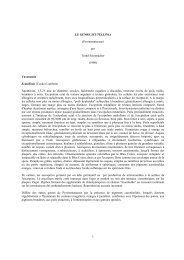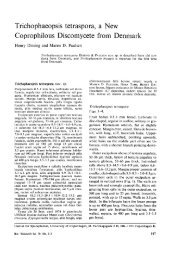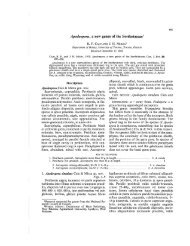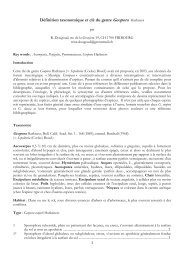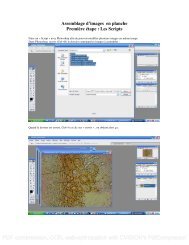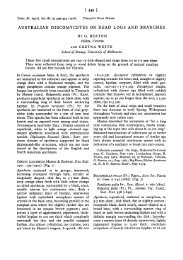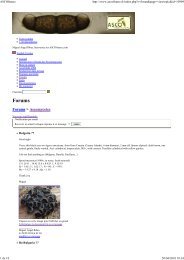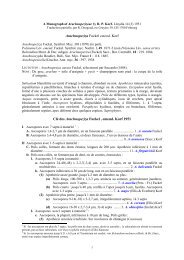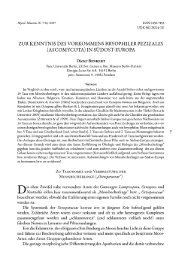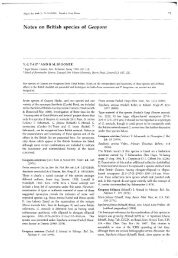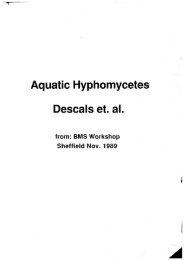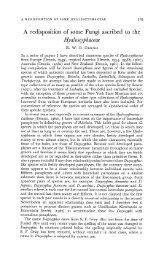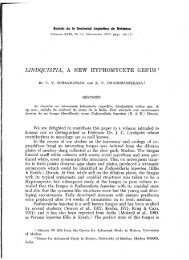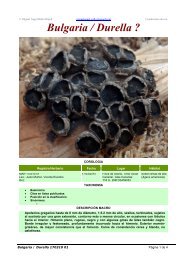Stray Studies in the Coronophorales (Pyrenomycetes) 4-8 - ASCOfrance
Stray Studies in the Coronophorales (Pyrenomycetes) 4-8 - ASCOfrance
Stray Studies in the Coronophorales (Pyrenomycetes) 4-8 - ASCOfrance
Create successful ePaper yourself
Turn your PDF publications into a flip-book with our unique Google optimized e-Paper software.
314 J. A. NannfeldtUPS! p.p. (una cum Chaet. phaeostr. et Ac. trist.), W! — Rbh., F. eur. 632 (Sph. trist). CUP,FH, NY fide Fitzp.; S!, UPS!, W! — Vize, Micro-f. brit. 391 FH fide Fitzp. — Westend., Herb,crypt. 528 (Hypox. cup.) COI!, LD! 1Subiculum scanty to profusely developed but never hid<strong>in</strong>g <strong>the</strong> ascocarps. Thesemedium-sized (0.3-0.5 mm), gregarious to scattered. Asci 8-sporous. Spores subcyl<strong>in</strong>dricalto subfusoid, mostly straight, 6-9x1.5-2.5 ¡j,m, hyal<strong>in</strong>e, with 2(-4) largedrops, eventually with a (pseudo?)septum.DISTRIBUTION: This seems to be one of <strong>the</strong> least rare and most widespreadtemperate species of <strong>the</strong> genus, be<strong>in</strong>g known with certa<strong>in</strong>ty from Europe (Sweden,Denmark, Norway, England, Belgium, Luxembourg, France, Germany, Switzerland),North America (Canada: Ontario and USA: Florida, Michigan, New York),and South America (Tr<strong>in</strong>idad, Fitzpatrick 1923:51). It is also recorded from Poland(Schroeter 1894:313) and Italy (Traverso 1907:359) as N. tristis and from Asia(Ch<strong>in</strong>a: Chekiang and Yunnan, Teng 1934: 369) as Cal. tristis. — The record of Cal.tristis from Africa (Ghana) by Hughes (1953:11) refers to N. calycuius(q.v.)(14) Nitschkia leonensis (Sivan.) Nannf. nov. comb.Scortech<strong>in</strong>iellopsis leonensis Sivan., Trans. Brit. Mycol. Soc. 62(1):37 (1974). — Typus:Sierra Leone, Deighton M 6233 (IMI!).Similar to N. acanthostroma but <strong>the</strong> repeatedly dichotomously branched subicu-Iar hyphae with pale, acum<strong>in</strong>ate (not sp<strong>in</strong>y) end<strong>in</strong>gs. Ascocarps 0.3-0.4 mm. Asci ca.32-sporous. Spores broadly allantoid to subreniform, 5-7x2-3 /xm, hyal<strong>in</strong>e, with 2large, often confluent drops, sometimes with a (pseudo?)septum.DISTRIBUTION: Tropical Africa (Sierra Leone). Only <strong>the</strong> type locality (3 f<strong>in</strong>ds,all on Cynometra leonensis).(15) Nitschkia macrospora Teng, S<strong>in</strong>ensia 4(12): 368 (1934).Typus: Yunnan, Tsiang 301 (n.v.).No subiculum. Ascocarps "seated on a pseudoparenchymatous stroma",0.35-0.55 mm, coarsely roughened, collaps<strong>in</strong>g. Asci 8-sporous. Spores allantoid,occasionally straight, very large (26-45x6-6.5 /xm), hyal<strong>in</strong>e, guttulate, eventuallywith a pseudoseptum. (Compiled from <strong>the</strong> diagnosis.)DISTRIBUTION: Asia (Ch<strong>in</strong>a: Yunnan). Only <strong>the</strong> type collection.(16) Nitschkia multiasca (Pat. & Gaill.) Nannf. nov. comb.Fracchiaea(?) multiasca Pat. & Gaill., Bull. Soc. Mycol. Fr. 4(3): 106 (1889). — Typus:Venezuela, Gaillard 1:24 p.p. (n.v.; comp. Fitzpatrick 1924:109).1 It seems to have rema<strong>in</strong>ed unobserved that <strong>the</strong>re exist two variants (editions?) of this exsiccatum. Thebound copy <strong>in</strong> LD has on <strong>the</strong> pr<strong>in</strong>ted label a more detailed locality than has <strong>the</strong> loose copy <strong>in</strong> COI.SvenskBot. Tidskr. 69 (1975)



